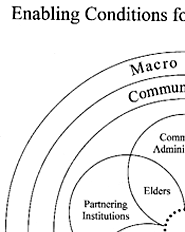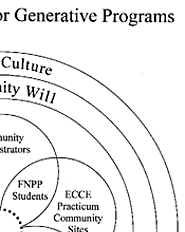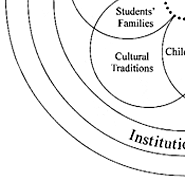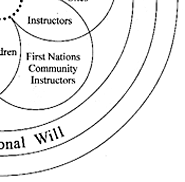PROGRAM PHILOSOPHY -- PARADIGM SHIFTProgram evaluation expanded our understanding of how the Generative Curriculum Model demonstrated by the First Nations Partnership Programs differs in fundamental ways from prevailing models of university education in general and from capacity building in Early Childhood Education and Youth Care in particular.
|
|
|
Co-constructing Curriculum with Cultural CommunitiesThe precise content of the training program is purposefully indeterminate to allow for co-construction of curriculum that has cultural relevance and resonance for the particular partners. The First Nations Partnership Programs do not start with a blank slate, but instructors and students are also not encouraged to adopt wholesale the scripted materials and resources provided by the university-based liaison team. Rather, a 'both/and' approach characterized the presentation of ideas, where both community specific and imported knowledge and practices are considered against program participants' understandings of the needs of children and families in their own community.
The Medicine Wheel teaches us about balance. When you do mainstream education in isolation from the community and without much personal connection to your own experiences and who you are, then you are only developing within the thinking / intellectual quadrant of the Medicine Wheel. This is out of balance. The wheel of development does not turn smoothly. When you involve your whole self, especially your spirituality, in learning, growth and development, and strengthen your connection with your community, especially the Elders and their spirituality, then you develop in all quadrants of the Medicine Wheel. Then you have balance. This program in child and youth care, using the Generative Curriculum Model, will enable us to get the wheel turning again in our community. Community-based administrators who contributed to program evaluation emphasized that for genuine partnership between the university and the students' communities to exist, First Nations people themselves must have a place at the table - to speak about their traditions, values and practices on children's care and development. Both the knowledge held in the university and the knowledge held in the community informed course design and delivery in each partnership program, bringing multiple perspectives into the field of Early Childhood Education and Youth Care. Our model for co-constructed bicultural curriculum captures the bridging dimensions of social cohesion and social inclusion in many different ways. In practice, the socio-cultural distance between a mainstream university and First Nations communities was greatly reduced: the university moved over, taking the passenger seat, and our First Nations partner took the driver's seat. The model below shows the many elements and perspectives that are brought into the teaching and learning process, contributing to the co-construction of curriculum.
A recurrent theme emerging in the program evaluation was the congruence of being involved in training that focused on their cultural and geographic community -- its goals for the well-being of children and families, socio-economic circumstances, readiness and strategies for responding to the needs of children and youth. Many students in the First Nations Partnership Programs have reported that the Generative Curriculum Model was a direct contrast to their previous experiences with mainstream educational institutions, which they described variously as "totally white," "impractical," "culturally contradictory," "spiritually bankrupt" and "foreign." Because this model adopts a 'both/and' approach that presents Euro-western theories and research in Early Childhood Education and Youth Care as an option to be considered alongside the traditions, values and practices of the students' own culture, the curriculum resonated with the realities of their daily lives.
Being responsive to indigenous communities means more than letting community members voice their concerns or preferences, more than acknowledging diversity. The program evaluation underscored the need for institutions involved in education, human services, and development assistance to open up the very foundations of how training programs are conceived and how optimal developmental outcomes are defined. As Vern Bachiu, the programs and policy director for the Meadow Lake Tribal Council, put it, "What we are trying to do is turn the world upside down." | |||||||||||




